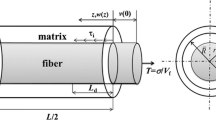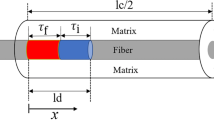A model is developed to analyze the growth of a fiber/matrix debond along a broken fiber interface in a single-fiber composite subjected to tension-tension fatigue. The Paris law expressed in terms of debond growth and strain energy release rates is used. An analytical solution for the Mode II energy release rate G II is obtained for long debonds, where the interface crack growth is self-similar. For short debonds, the interface crack interacts with the fiber break, and therefore a FEM modeling in combination with the virtual crack closure technique was performed to calculate the increase in G II . Finally, the calculated G II dependences are summarized in simple expressions that are used to simulate the debond growth in fatigue. A parametric study of the effect of Paris law parameters on the debond growth is performed.











Similar content being viewed by others
References
A. Pupurs and J. Varna, “Energy-release-rate-based fiber/matrix debond growth in fatigue. Pt. I: Self-similar crack growth,” Mech. Adv. Mater. Struct. (2011) (in press).
A. Pupurs, A. Krasnikovs, and J. Varna, “Energy-release-rate-based fiber/matrix debond growth in fatigue. Pt. II: Debond growth analysis using the Paris law,” Mech. Adv. Mater. Struct. (2011) (in press).
A. Kelly and W. R. Tyson, “Tensile properties of fibre-reinforced metals: copper/tungsten and copper/molybdenum,” J. Mech. Phys. Solids, 13, 329–350 (1965).
S. Goutianos and T. Peijs, “Experimental and numerical investigation into fatigue damage mechanisms in multifibre microcomposites,” Plast., Rub. Compos., 30, 222–232 (2001).
J. A. Nairn, “A variational mechanics analysis of the stresses around breaks in embedded fibers,” Mech. Mater., 13, 131–154 (1992).
J. Varna, R. Joffe, and L. A. Berglund, “Interfacial toughness evaluation from the single-fiber fragmentation test,” Compos. Sci. Technol., 56, 1105–1109 (1996).
J. A. Nairn and Y. C. Liu, “Stress transfer into a fragmented, anisotropic fiber through an imperfect interface,” Int. J. Solids Struct., 34, 1255–1281 (1997).
W. Wu, I. Verpoest, and J. Varna, “A novel axisymmetric variational analysis of stress transfer into fibres through a partially debonded interface,” Compos. Sci. Technol., 58, 1863–1877 (1998).
W. Wu, I. Verpoest, and J. Varna, “Prediction of energy release rate due to the growth of an interface crack by variational analysis,” Compos. Sci. Technol., 60, 351–360 (2000).
E. Graciani, V. Mantic, F. Paris, and J. Varna, “Numerical analysis of debond propagation in the single-fibre-fragmentation test,” Compos. Sci. Technol., 69, 2514–2520 (2009).
ANSYS Release 11.0, ANSYS Academic Research, ANSYS Inc., Canonsburg, Pennsylvania (2007).
G. R. Irwin, Fracture, Handbuch der Physik. Vol. 5, Springer Verlag, Berlin (1958).
A. S. D. Wang, P. C. Chou, and S. C. Lei, “A stochastic model for the growth of matrix cracks in composite laminates,” J. Compos. Mater., 18, 239–254 (1984).
Z. Hashin, and B. W. Rosen, “The elastic moduli of fiber-reinforced materials,” J. Appl. Mech., 31, 223–232 (1964).
Z. Hashin, “Analysis of composite materials — a survey,” J. Appl. Mech., 50, 481–505 (1983).
Author information
Authors and Affiliations
Corresponding author
Additional information
Russian translation published in Mekhanika Kompozitnykh Materialov, Vol. 47, No. 1, pp. 151–174, January-February, 2011.
Appendix
Appendix
Distribution of stresses. The two cylinder model shown in Fig. 2 is subjected to a constant strain εz0 in the axial direction, resulting from the displacement u z0/2 applied at both its ends, and to a temperature increment ΔT. In the bonded case, the axial strain in the fiber and matrix is the same, but in the debonded one, only the matrix is subjected to εz0. The expressions given below follow from Appendix 2 in [8] and are valid both for bonded and debonded cases. The procedure of their derivation is the same as in [14,15].
Both constituents of the composite are transversely isotropic and follow Hooke’s law, which for normal stresses here can be written in form
where C ij is the stiffness matrix and α j are the thermal expansion coefficients. Here, 3 is the axial direction, and 1 and 2 are two orthogonal directions in the plane of isotropy. All shear stresses are zero.
The elastic solution valid for any transversely isotropic cylindrical phase under this type of loading can be written as
Here, new constants have been introduced:
An additional superscript k is also introduced, where k= 1 and 2 for the fiber and matrix, respectively, to mark the constants of the constituents.
The unknown constants \( A_1^k \) and \( A_2^k \), k= 1 and 2, have to be determined from the following conditions:
-
the radial displacements are zero on the symmetry axis,
-
the displacements and radial stresses are continuous at the interface,
-
the radial stresses at the outer boundary r=R of the cylinder assembly are zero,
From Eq. (A2), we obtain that \( A_2^1 = 0 \). For given εz0 and ΔT, the system of three equations following from conditions (A3)-A(5) allows one to determine the three constants \( A_1^1 \), \( A_1^2 \), and \( A_2^2 \). Obviously, their values will depend on the strain εz0 and the temperature increment ΔT applied.
Rights and permissions
About this article
Cite this article
Pupurs, A., Varna, J. Fracture mechanics analysis of debond growth in a single-fiber composite under cyclic loading. Mech Compos Mater 47, 109–124 (2011). https://doi.org/10.1007/s11029-011-9190-1
Received:
Published:
Issue Date:
DOI: https://doi.org/10.1007/s11029-011-9190-1




